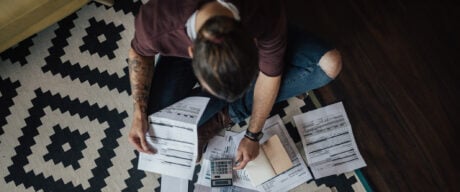
Revolving credit is a line of credit you can borrow against and pay down repeatedly over time, like credit cards or home equity lines of credit (HELOCs).

Revolving credit allows you to borrow, repay and re-borrow against the same line of credit repeatedly over time. Examples of revolving credit include credit cards or home equity lines of credit.
Taking the time to understand the differences between revolving debts, installment debts and lines of credit will help you use these financing options properly while maintaining a healthy credit score.
With revolving credit, also known as open credit, you are usually given a credit limit which is the maximum amount that you can borrow from or charge to that specific account.
Every time you borrow money or make a purchase from the account, less less credit will be available to you. However, every time you make a payment, you will have that credit space available to you again to use when needed.
Revolving credit accounts are often open-ended, so there is no official limit on how long you can use it, and no set number of payments after which you will have “paid off” the loan. You just need to keep your account open and remain in good standing to be able to continue to use a line of revolving credit. This means making payments on time and according to the minimum amount specific in your contract.
The balance and your minimum payment due may vary month to month because it will depend on how much of the credit you have used during that time.
Revolving debts can have an impact on your credit score in multiple ways.
Making regular payments on revolving debts, ideally in full, can strengthen your credit score, while missing payments or being unable to pay the minimum amounts may weaken it.
You also need to take note of your credit utilization ratio, which makes up a large portion of your credit score. Ideally, only 30% of your available credit would be in use at a time. The more credit you have available, the more you can borrow without exceeding this benchmark. High credit utilization is a red flag that you may be overextended and can have a negative impact on your credit score.
Finally, simply applying for and cancelling credit cards or other forms of revolving credit can impact your credit score. Applying for multiple lines of credit at once may result in several hard inquiries on your credit report, each of which can have a temporary negative effect. If you want to cancel a card, doing so the proper way can help avoid a dip in your score.
Installment credit is essentially the opposite of revolving credit. It’s a lump sum loan that is borrowed and paid back in a set amount of time. Once the loan is issued, you must make required minimum payments in order to pay it off according to schedule. You don’t earn more credit room with each payment. If you need more credit, you need to take out another loan.
Payment history plays a big role in your credit score, so you want to ensure that you pay off your installment loans in a timely manner as set out in your contract. Doing this can be a big boost to your credit score. If you are unable to keep up with scheduled payments, then your credit score can take a hit.
A line of credit is an agreement between an individual and a financial institution that allows the client to borrow money when needed. There is a maximum amount of credit available that can be tapped into and used at any time until that limit is reached, which provides a lot of flexibility.
Lines of credit can be secured, which means some form of collateral (often a home) secures the debt, or unsecured. They can also be open (revolving) or closed (a fixed number of installments). It depends on your agreement with the lender. Each line of credit is personalized to the client.
A line of credit offers great flexibility, but if you aren’t careful you can misuse it and overspend. As with the other types of debt, it is important to keep up with required payments to keep your credit score in good standing.
Hannah Logan is a freelance writer and blogger who specializes in personal finance and travel. You can follow her personal travel blog EatSleepBreatheTravel.com or find her on Instagram @hannahlogan21.

NerdWallet Canada’s picks for the best credit cards include top contenders across numerous card categories. Compare these options to find the ideal card for you.

Debt can be divided into several types: secured and unsecured, good and bad. Other types of debt include credit card debt, student loans, medical bills and mortgages.

Facing your balances, making a budget and choosing the right payoff strategy can help you deal with debt in the new year.
 How to Get Out of Credit Card Debt" width="460" height="191" />
How to Get Out of Credit Card Debt" width="460" height="191" />
Out-of-control credit card debt can hurt your credit, affect your family and limit your financial freedom.